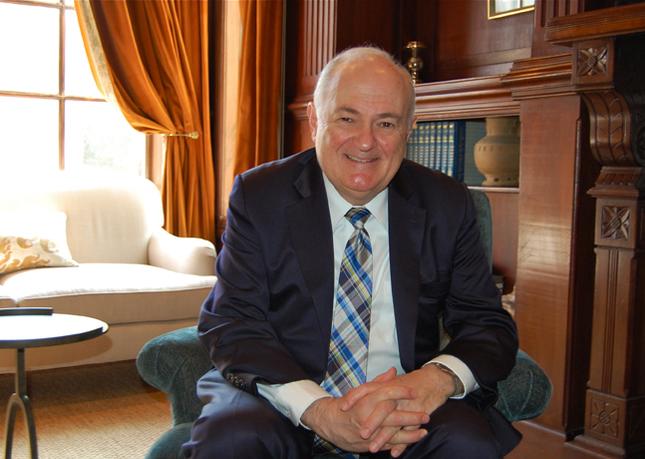Steven Knapp’s Wide Embrace: GW and the Arts
By • May 21, 2015 0 1292

There is a lot more to Steven Knapp, 16th president of the George Washington University, than meets the eye.
Standing up and speaking at the George Town Club recently, the last of the spring speakers in Georgetown Media Group’s Cultural Leadership Breakfast Series, is one sort of person, an affable, impressive man talking about a range of subjects, but focused on the university’s rise to its own cultural leadership role in Washington.
But this is the same man who – when he became president of the university in 2007 after a stint as provost at Johns Hopkins – focused on building the stature of the university as an “intellectual contributor to the solution of national and global problems,” presided over the building of a new Science and Engineering Hall and hired a neurobiologist as president of research.
Talking with him later in a corner of the George Town Club, and reading about the man on paper, you get a sense of how it all fits together.
“You can no longer focus on one thing in terms of leadership, in terms of the kind of university we are,” he said. This, to him, is about being an urban institution of learning in Washington, “the most unique city in the country.”
What’s happened is also a reflection of the man who wanted to be a percussionist and still plays, who thinks that Dostoevsky is relaxing reading and who bonded with students who were initially skeptical of him by participating (at some risk) in a snowball fight.
His memberships and leadership in any number of organizations reflect a drive toward cross-pollination, not only of disciplines but of institutions and of intellectual and artistic taste. He has seen the future – for quite a while now – and finds it rife with opportunities for collaboration.
“Our world,” he has said, “has reached a level of complexity at which problems can no longer be solved by relying on the contributions of any single discipline.”
You have to think a little about his specialty: Romanticism, literary theory and the relation of literature to philosophy and religion. A longtime teacher of English literature at the University of California, Berkeley, Knapp is used to dealing with intersections in thinking and creating; he knows how poetry can become infused – in the case of a Blake or a Coleridge – with matters near-holy.
The arts were a place rife with opportunity. GW was a major player, along with Arena Stage and, later, other universities and theater companies, in the National Civil War Project conceived by choreographer Liz Lerman, a GW alumna. “It was something important, and it was a chance to work with other institutions for me and for us. It was a great experience.”
“The arts are the source of innovation, a constant search for innovation, and we have to do everything in our power to become involved, to innovate and lead, in the arts,” he said.
His belief and focus on enhancing partnerships with neighboring institutions couldn’t be better illustrated than by the moves GW and Knapp have made over the last two years.
In 2014, GW joined with the National Gallery of Art to assume responsibility for the Corcoran, saving the venerable museum and its art school, which was merged into GW’s Columbian College of Arts and Science. According to Knapp, there will continue to be art on display in the landmark 17th Street building – the National Gallery, which has control of the collection, is planning to mount “Corcoran Contemporary” exhibitions and to show works representative of the Corcoran legacy – free of charge. The college is now called the Corcoran School of the Arts and Design, the plural suggesting that studies in the non-visual arts will be added.
The university also took under its wing the Textile Museum, a small, almost unassuming institution of the kind often described as a hidden treasure. Hidden no longer, the Textile Museum moved from its former location on S Street to its current one on the GW campus at 21st Street. Its new building, connected to historic Woodhull House, now home to the Albert H. Small Washingtoniana Collection, is part of the complex called the George Washington University Museum and the Textile Museum.
In the May 6 issue of The Georgetowner, Ari Post called the Textile Museum’s “Unraveling Identity” exhibition “a well-earned retrospective of the museum’s historic collection of textiles, spanning centuries and almost every continent.”
In addition, the university has a high functioning, high profile performing arts center at the Lisner Auditorium, where Executive Director Maryann Lombardi oversees a program laden with global performers and artists.
It’s all of a piece for Knapp: science and pragmatics, the Economics Council as well as the NSO board, drums and snowballs, art singular and the arts plural, textiles and Washingtoniana, being part of the city and a citizen of the world. His wide embrace suits a university whose mission – from its namesake – was and is to “educate future leaders, not only for the nation, but for the world.”

